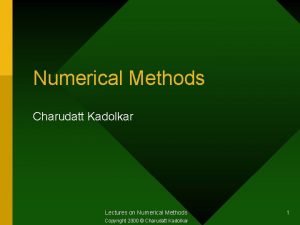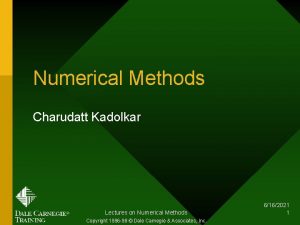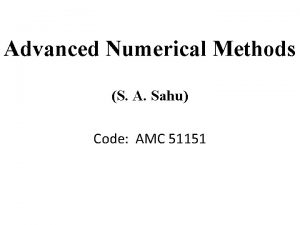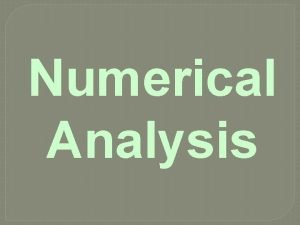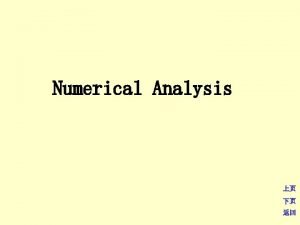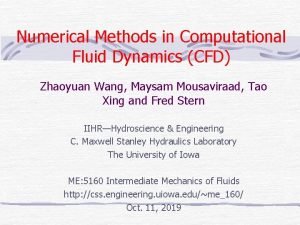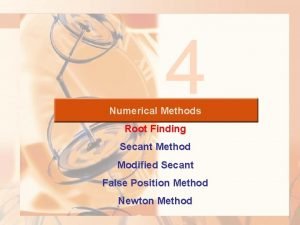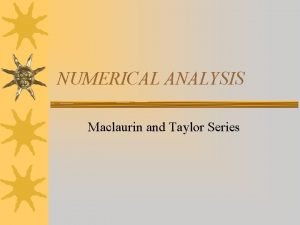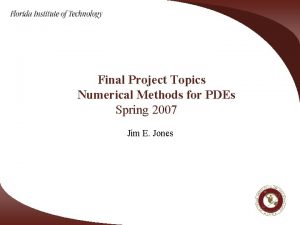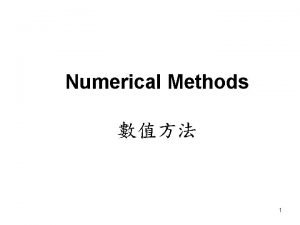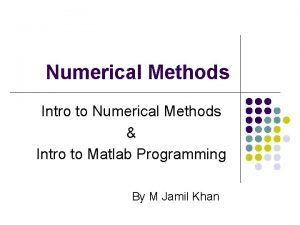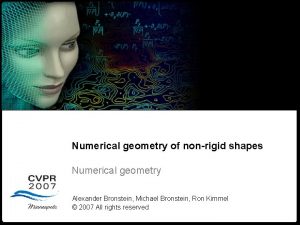Numerical Methods Charudatt Kadolkar Lectures on Numerical Methods









- Slides: 9

Numerical Methods Charudatt Kadolkar Lectures on Numerical Methods Copyright 2000 © Charudatt Kadolkar 1

Nonlinear Equations: Roots – Objective is to find a solution of F(x) = 0 Where F is a polynomial or a transcendental function, given explicitly. – Exact solutions are not possible for most equations. – A number x ± e, ( e > 0 ) is an approximate solution of the equation if there is a solution in the interval [x-e, x+e]. e is the maximum possible error in the approximate solution. – With unlimited resources, it is possible to find an approximate solution with arbitrarily small e. Lectures on Numerical Methods 2

Nonlinear Equations: Roots – If the function F is calculated using floating point numbers then the rounding-off errors spread the solution to a finite interval. – Example – Let F(x) = (1 – x)6. This function has a zero at x = 1. Range of the function is nonnegative real numbers. – It is not possible to obtain an answer that is more accurate than second decimal place. Show graph Lectures on Numerical Methods 3

Bisection Method Let F(x) be a continuous function and let a and b be real numbers such that f(a) and f(b) have opposite signs. Then there is a x* in interval [a, b] such that F(x*) = 0. Then c = (a + b)/2 is an approximate solution with maximum possible error (b – a)/2. If f(c) and f(a) have opposite signs then the solution x* is in the interval [a, c]. Then, again, d = (c + a)/2 is an approximate solution but with max possible error (b – a)/4. Else the solution is in the interval [c, b]. The approximate solution now is (c+b)/2 with max possible error (b-a)/4. Continuing this process n times we can reduce the max possible error to (b-a)/2 n. Lectures on Numerical Methods 4

Bisection Method Algorithm 1. Let a and b be such that f(a)*f(b) < 0 2. Let c = ( a + b ) / 2 3. If f(a) * f(c) < 0 then b = c else a = c 4. If more accuracy is required go to step 2 5. Print the approximate solution (a + b)/2 Example Lectures on Numerical Methods 5

Regula Falsi Method Algorithm 1. Let a and b be such that f(a)*f(b) < 0 2. Let c = ( f(b)*a – f(a) * b ) / (f(b) – f(a)) 3. If f(a) * f(c) < 0 then b = c else a = c 4. If more accuracy is required go to step 2 5. Print the approximate solution (a + b)/2 Example Lectures on Numerical Methods 6

Terminating Iterative Method – Let eps > 0 be a small number. – |b – a| < eps – |b – a| / |a| < eps – | f(c) | < eps – Number of iterations Lectures on Numerical Methods 7

Newton Raphson Method Algorithm 1. Input x. Old 2. x. New = x. Old – f(x. Old) / f’(x. Old) 3. If not satisfied go to step 2 4. Print x. New Lectures on Numerical Methods 8

Fixed Point Iterations Convert the given equation in the form x = g(x) Examples x 2 – 1 = 0 can be written as x = 1 / x or x = x 2 + x – 1 x 2 + x – 2 = 0 can be written as x = 2 – x 2 x = sqrt(2 – x) Lectures on Numerical Methods 9

